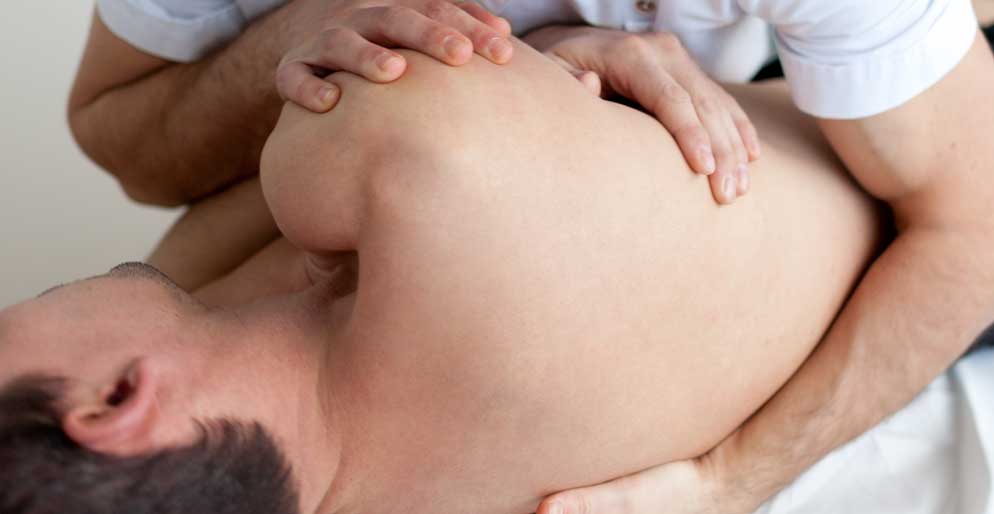What is Chiropractic?
Chiropractic is specialised treatment for the spine, muscles and joints. It is a safe, hands-on way to free stiff or tight joints, muscles, tendons and nerves. It includes joint manipulation and muscle balancing techniques, together with exercise and postural advice ensuring long term improvement. No drugs, surgery or invasive techniques are used.
Chiropractors see patients primarily to help them out of pain, back to work and to resume activities of daily as soon as possible. Some clients can be completely cured whilst for others Chiropractic gives an improved quality of life, and helps them manage their daily activities or work in comfort. It can benefit people of all ages from the young to the elderly.

What conditions can Chiropractic treat?
Chiropractic is particularly effective at treating back pain, along with neck pain, headaches and associated nerve problems such as sciatica or arm pain. A wide range of other joint and muscle injuries are treated, including those to the shoulder, hip, knee, elbow, ankle, wrist, hand and foot.
Sports injuries respond very well. For athletes, Chiropractic can help a quicker return to activity, improve their physical performance and help prevent injury.
Pregnant women – I have treated many pregnant women with back pain. This can assist the pain before birth, reduce labour pain and help the pelvis realign more smoothly after birth.
Arthritis cannot be cured with Chiropractic although treatment may reduce the pain and considerably improve quality of life.
Chiropractic treatment involves three main methods:
- Joint manipulation or adjustment
- Massage or deep muscle release
- Lifestyle education to help prevent the condition from recurring
1. Chiropractic manipulation or ‘adjustment’
Chiropractic manipulation consists of gently unlocking the stiff joints with skilled specific movements, which use just the right amount of directed force to restore full movement and alignment to the joints. This can also be called ‘Chiropractic adjustment’, which frees the tight joints, reduces the surrounding muscle spasm, improves blood circulation and nerve control, thereby simultaneously stabilising and strengthening the joints, helping the core muscles to be active, flexible and resilient. A wide variety of adjusting techniques are used and tailored to each individual. For more information, please see my articles:
The effects of Chiropractic Manipulation
Restores movement in the locked or stiff joints
Balances the surrounding muscles – helping the muscles in spasm to relax and those that are not responding properly to start working.
It ‘puts your bones back into place’ is an old saying, but some patients report after treatment as if their bones ‘feel ‘back in place’ or are ‘more aligned’, although technically it’s the joints, including both the bones and muscles, that are balanced. (see Chiropractic History and Philosophy)
2. Combining Chiropractic joint manipulation with massage
I believe in deep muscle release, alongside joint manipulation, which helps the pain to settle and the injury to heal more quickly. I would describe my massage as a mixture of various techniques and years of developed experience from both my Chiropractic and Alexander Technique trainings. Sometimes a more gentle, relaxing massage is indicated, especially if there is too much tenderness, to give the muscles time to let go and release, even working around and away from the main tightness, whilst at other times specific holding, pressure or kneading pin-point to the tight or ‘trigger’ spots is required. I have various alternative ways to release muscle spasm which I frequently use when treating. The massage balances the surrounding muscles. Some clients find massage to the injury helps the muscles to relax before the joint adjustment, whilst for other clients it’s important to release the joints before the muscles can relax. There’s no one exact approach.
3. Lifestyle education
It is my passion for keeping a healthy lifestyle, with plenty of exercise and purposeful resting, that helps the muscles release further, thereby helping them not to slip back into the habitual pattern of tightness and spasm that can help the long-term improvement.
Jeremy has been an amazing chiropractor. He’s an incredibly caring and supporting professional who has always provided me with the highest quality of service I’ve ever experienced. He’s taken care of me for over 6 years and not once has he failed to uphold the absolutely highest professional service possible. I highly recommend him.
– Joanna
Tailoring Chiropractic treatment to the individual
Chiropractic treatment doesn’t always require joint manipulation!
Joint manipulation is not suitable in all circumstances, for example if there had been previous surgery, the joint is recovering from a fracture, or if there is osteoporosis or brittle bones. Sometimes clients are too sensitive or elderly and sometimes clients simply do not like me to adjust the joints, either being too noisy with joint pops, or simply find that it either aggravates the condition or is not helping the injury to settle. There can be clear medical indicators or red flags when not to adjust the joints which are discovered when taking the history, at other times it is experience that guides my judgment. Above all, it’s with clear feedback and communication with clients that the right treatment approach is discovered. The ‘When not to manipulate’ case study is an interesting example.
Will I feel worse after receiving chiropractic treatment?
Chiropractic treatment can cause some short-term stiffness and aching. In most cases this is a good thing as it is a sign that your body is adapting to the adjustments. These reactions are normally minor and should soon pass as your body adjusts, usually in a day or so. Indeed, you may not experience any of these reactions, and may just ‘feel better’. Some clients feel tired and want to just sleep after treatments, whilst others seem to have more energy.
What should I do after treatment?
Simply put: take it easy, don’t overstrain the joints and don’t sit too long! Please don’t plan any long car journeys, travelling or heavy work after treatment if possible. Vary your activity, move regularly, sit minimally and perhaps rest your back lying down. You will be advised more specifically when you attend treatment. More information is written in home care after Chiropractic treatment.
